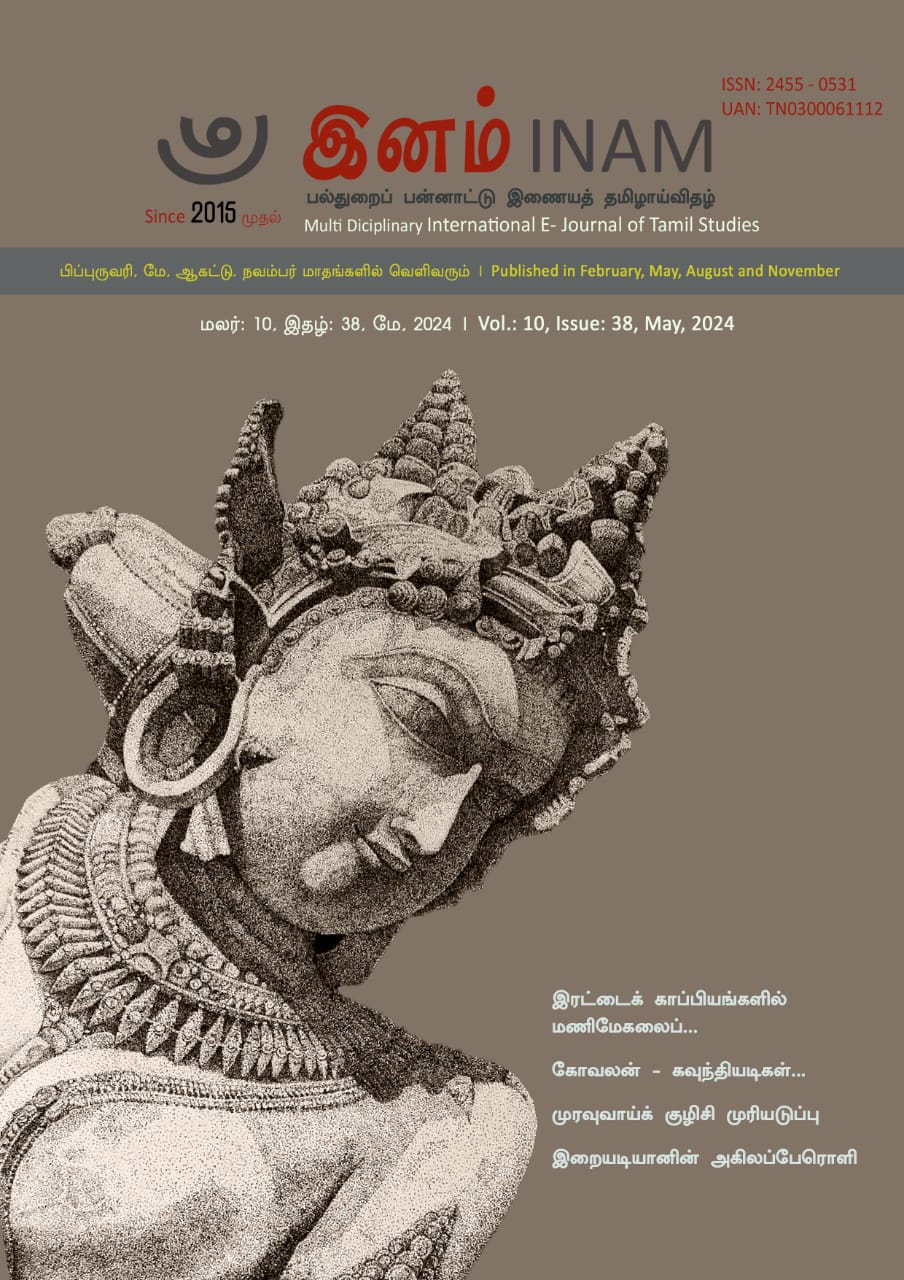சொல் எனும் சோலையிலே திருக்குறளும் தம்மபதமும் Thirukkural and Dhammapadam in the oasis of words
Keywords:
அமைப்பியல், வாழ்வியல் நீதி, சொல் கருத்தியல், உத்திகள், அறிவுடைமை, வாய்மைAbstract
‘சொல்’ எனும் சோலையிலே வளர்ந்து நின்ற கற்பக விருட்சங்களில் ஒன்று உலக பொதுமறையாம் திருக்குறள், மற்றொன்று உலகெங்கும் போற்றப்பெறும் புத்தபகவானால் போதிக்கப்பெற்ற தம்மபதம், இவ்விரு நுல்களிலும் எடுத்துரைக்கப்பட்டுள்ள ‘சொல்’ தொடர்பான சிந்தனைக் கூறுகளை முதன்மைத் தரவுகளாகக் கொண்டு இவ்வாய்வுக்கட்டுரை அமைக்கப்படுகிறது. திருக்குறள் மற்றும் தம்மபதம் இரண்டுமே உலக மக்கள் அனைவருக்கும் பொது வாழ்வியல் அறத்தை எடுத்துரைக்கும் நீதி நூல்களாக வாழ்வியல் அறநெறியை உலகெங்கும் பரப்பும் உன்னத நோக்கில் அமைப்பப்பட்ட நூல்களாகும். இந் நூல்களில் ‘சொல்’ எனும் கருத்தியலில் கூறப்பெற்ற ‘அறச்சிந்தனைகள்’ பொது உடைமையாகவே அமைந்துள்ளன என்ற கருதுகோளின் அடிப்படையில் இக்கட்டுரை நகர்ந்து செல்கின்றது.
மேற்கூறிய இரு நூல்களிலும் சொல்லப்பெற்ற ‘சொல்’ தொடர்பானத் தரவுகளை ஆதாரமாக அமைத்துக் கொண்டு 1.அமைப்பியல் 2. உத்திகள் 3. கருத்தியல் எனும் தலைப்புக்களில் விளக்கபட்டுள்ளது. அமைப்பியல் எனும் தலைப்பின்கீழ் இரு நூல்களின் புற, அகக் கட்டமைப்புகளை விளக்கப்படுகிறது.
கருத்தியல் அடிப்படையில் ‘சொல்’ எனும் கருத்தை திருவள்ளுவர் – “யாகாவாராயினும் நாகாக்க காவாக்கால்
சோகாப்பர் சொல் இழுக்குப்பட்டு”
எனக்கூறி, உலக மக்கள் அனைவரும் பயன்படுத்தும் சொற்களை நெறிமுறைப் படுத்தியுள்ளார். இதனை, நீத்தார் பெருமை, அறன் வலியுறுத்தல், இனியவைக்கூறல், நடுவு நிலைமை, பொறையுடைமை, பயனில சொல்லாமை, வாய்மை, கல்லாமை, கேள்வி, அறிவுடைமை, குற்றம் கடிதல், பெரியாரைத் துணைக்கோடல், சொல்வலிமை, வினைத் திட்பம், வினை செயல்வகை, தூது, மன்னரைச் சேர்ந்தொழுகுதல், குறிப்பறிதல், அவையறிதல், அவையஞ்சாமை, அரண், தீநட்பு, கூடாநட்பு, கயமை போன்ற 24 அதிகாரங்களில் 100 குறட்பாக்கள் வழி ‘சொல்’ கருத்தியல் விவரிக்கப்பட்டுள்ளது. திருவள்ளுவர் கூறிய ‘சொல்’ தொடர்பான இச்சிந்தனையையே புத்த போதனைகள் என்று கூறப்படும் 26 வர்கங்களும், 423 காதைகளும் கொண்ட ‘தம்மபதம்’ நூலின் ‘சொல்’ சிந்தனையோடு ஒப்பிட்டு சான்று காட்டி விளக்கப்படுகிறது.
உத்திகள் அடிப்படையில் திருவள்ளுவர் மற்றும் புத்தர் மக்களுக்கு வாழ்வியல் நீதியை எடுத்துரைக்கும் வண்ணம் அவர்களால் கையாளப்பட்ட உத்திகள் (உவமைகளாக, நேரடியாக, மறைமுகமாக, பலன்களாக, அஃறிணைப் பொருள்களாகக் கூறல் போன்றவை) பலவற்றையும் ஆராய்ந்து ஒப்பிடப்பட்டுகிறது.
One of the great trees that grew in the oasis of 'col' is Thirukkural, which is universally known, and the other is Dhammapadam, which is taught by Lord Buddha, who is admired all over the world. Both Thirukkural and Dhammapadam are books of justice that teach the common morality of life to all the people of the world and are written with the noble aim of spreading morality of life throughout the world. This article moves on the basis of the hypothesis that the 'moral thoughts' expressed in the concept of 'word' in these books are public property.
Based on the data related to the 'word' mentioned in the above two books, it is explained under the headings of 1. Book Structure, 2. Techques 3. Ideology.
The external and internal structures of both texts are explained under the heading of structure.
Conceptually based on the concept of 'word' Thiruvalluvar -
yaavaagaraayinum naakaakka kaavaakkaal
cookaappar col izhukkuppattu
According to him, he has standardized the words used by all the people of the world. This is called pride, virtue emphasis, pleasuring, middle ground, endurance, useless speech, dumbness, stupidity, questioning, lack of knowledge, blame bite, Periyar subtext, speechlessness, verb tense, verb function, messenger, kingship, notation, knowing, lack of speech. , the concept of 'col' is described through 100 Kuratpas in 24 chapters like Aran, Deenadpu, Kudanadpu, Kayamai etc. Thiruvalluvar's thought about 'word' is compared with the thought of 'word' in the book 'Dhammapadam', which has 26 classes and 423 kathas, which are said to be Buddhist teachings.
In terms of strategies, many of the strategies used by Thiruvalluvar and Buddha to convey the justice of life to the people (as metaphors, direct, indirect, benefits, etc.) are analyzed and compared.
References
மாணிக்கம்.சே (2012), திருக்குறள் தெளிவுரை, சிவா பதிப்பகம், தஞ்சாவூர்.
மகாதேவன்.டி.எம்.பி. (1952): அப்பாதுரை எம்.ஆர்.(பதி.), தம்மபதம், (தமிழ் மொழிபெயர்ப்பு), சென்னை.
சசிவர்ணத் தேவர். (2023, மே 7). விக்கிப்பீடியா. Retrieved 15:55, மே 27, 2024 from https://ta.wikipedia.org/s/7uez
buddhanet- https://www.buddhanet.net/pdf_file/scrndhamma.pdf, Retrieved 15:55, மே 27, 2024
திருக்குறள் - திருவள்ளுவர், http://www.thirukkural.com/2009/02/blog-post_1935.html?m=1, Retrieved 15:55, மே 27, 2024
தமிழ் கற்போம் - https://www.ytamizh.com/thirukural/kural-1112/#google_vignette, Retrieved 15:55, மே 27, 2024
திருக்குறள் - https://thirukkural.io/112/nalampunaindhuraithal/, Retrieved 15:55, மே 27, 2024
Mokshananda Buddhavihara – https://www.youtube.com/@mokshanandabuddhavihara9237, Retrieved 15:55, மே 27, 2024
Downloads
Published
Issue
Section
License
Copyright (c) 2024 இனம்: பல்துறைப் பன்னாட்டு இணையத் தமிழாய்விதழ் (Inam: Multidisciplinary International E-Journal of Tamil Studies)

This work is licensed under a Creative Commons Attribution-NonCommercial-NoDerivatives 4.0 International License.



